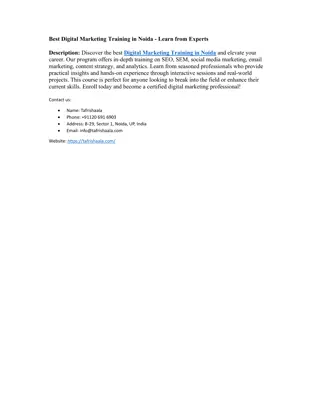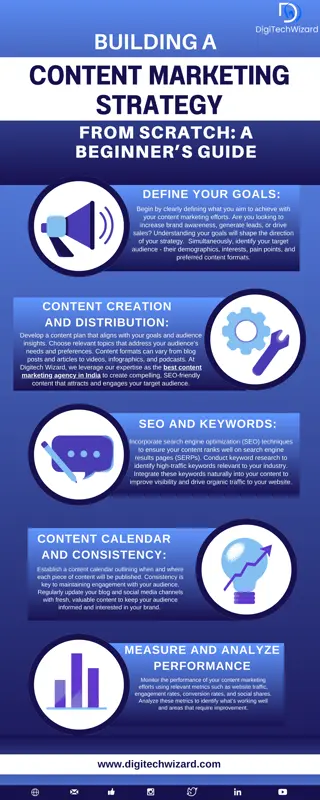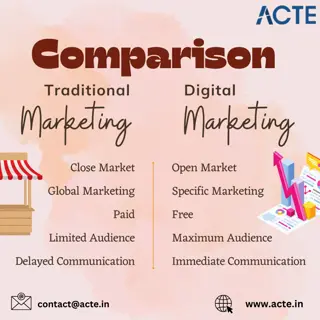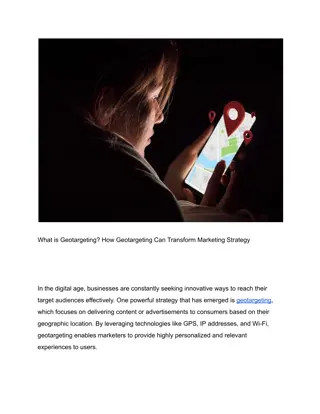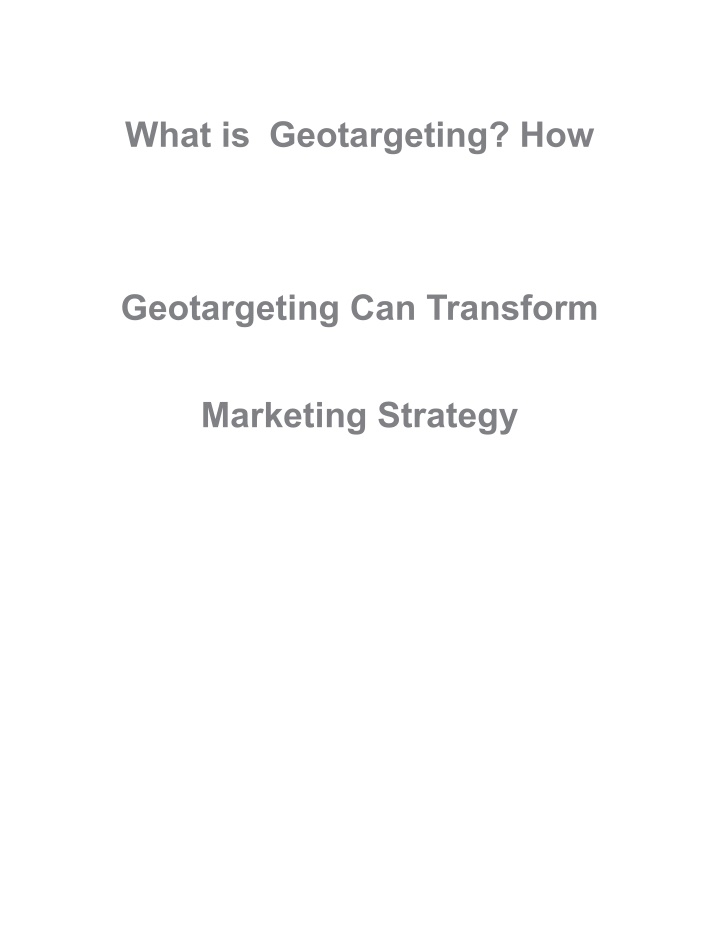
What is Geotargeting_ How Geotargeting Can Transform Marketing Strategy
Geotargeting is the practice of showing consumers material or adverts according to where they are in the world.
Download Presentation

Please find below an Image/Link to download the presentation.
The content on the website is provided AS IS for your information and personal use only. It may not be sold, licensed, or shared on other websites without obtaining consent from the author. If you encounter any issues during the download, it is possible that the publisher has removed the file from their server.
You are allowed to download the files provided on this website for personal or commercial use, subject to the condition that they are used lawfully. All files are the property of their respective owners.
The content on the website is provided AS IS for your information and personal use only. It may not be sold, licensed, or shared on other websites without obtaining consent from the author.
E N D
Presentation Transcript
What is Geotargeting? How Geotargeting Can Transform Marketing Strategy
Geotargeting is the practice of showing consumers material or adverts according to where they are in the world. This approach relies on: IP addresses GPS data Wi-Fi networks Cellular data
These data points help marketers customize user experiences according to regional preferences and behaviors. The following strategies can be applied: 1. Personalized advertisements 2. Localized promotions 3. Region-specific content It enables businesses to: Increase engagement rates Improve conversion rates Enhance customer experiences By leveraging location-based data, companies can refine marketing efforts, targeting users more effectively within specific regions. Geotargeting Geotargeting is a marketing strategy that delivers content based on a user s geographic location. It uses data such as IP addresses and GPS signals to identify the location. The core components involved include: IP Address: Determines the user s internet location. GPS: Uses satellite data for precise positioning. Wi-Fi and Bluetooth: Help in indoor location tracking. User Preferences: Past location data and user history.
Businesses can use this data to: 1. Customize website content for different regions. 2. Offer region-specific promotions. 3. Target local customers more effectively. By using location to increase engagement, it offers a more customized user experience. How Geotargeting Works Geotargeting utilizes geographic data to deliver tailored content and advertisements. Key mechanisms include: 1. IP Address Tracking: Uses the internet IP address of the user to determine their location. 2. GPS Data: Uses location services from mobile devices for precise targeting. 3. Wi-Fi Triangulation: Determines user position through Wi-Fi signals in the vicinity. 4. Beacon Technology: Makes use of Bluetooth beacons to communicate with adjacent mobile devices. 5. Cell Tower Data: Tracks location through connection to cellular towers. These methods help marketers customize campaigns, ensuring relevance and increasing engagement by addressing users based on their locales.
Benefits of Using Geotargeting in Marketing Several benefits of it can greatly improve marketing initiatives. Increased Relevance: Marketing messages tailored to specific locations ensure higher relevance and engagement. Cost Efficiency: Reduces wasted ad spend by targeting ads only to relevant geographic locations. Improved Conversion Rates: Localized offers and promotions can drive higher conversion rates. Enhanced Customer Insights: Provides valuable data on regional preferences and behaviors. Competitive Advantage: Allows businesses to outmaneuver competitors with precise, location-based strategies. Better Customer Experience: Personalized, local content improves overall customer satisfaction and loyalty. Evidence shows that using it in marketing can lead to more impactful campaigns. Geotargeting vs. Traditional Marketing Methods Geotargeting utilizes location data to deliver personalized content to users based on their geographic location. Traditional marketing methods, on the other hand, rely on broader strategies
such as television ads, print media, and billboards which aim to reach a wide and often unspecified audience. Key Differences: Precision: Geotargeting offers precise targeting by region, city, or even specific coordinates. Traditional marketing lacks this granularity. Cost Efficiency: It often results in reduced costs by focusing on relevant audiences. Traditional methods can be more expensive due to a lack of focus. Engagement: Enhanced engagement through localized offers and messages in geotargeting. Traditional methods may not engage local communities effectively. Measurability: Immediate feedback and analytics are available with it. Traditional marketing relies on delayed, less precise impact measures. Types of Geotargeting Techniques Location-Based Advertising: Tailors marketing messages to users based on their real-time geographic location using GPS data. Geofencing: Defines a virtual boundary around a specific area; triggers ads or notifications when users enter or leave this zone. Beacon Technology: Uses Bluetooth signals to communicate with nearby devices within a short range for hyper-local promotions. IP Address Targeting: Identifies a user s geographic location based on their IP address to customize content and ads.
ZIP Code Targeting: Focuses marketing efforts on users within specific ZIP codes for localized campaigns. Geotargeting via Social Media: Utilizes location data from social media profiles to deliver targeted content and ads. Implementing Geotargeting in Digital Advertising Geotargeting in digital advertising can enhance campaign effectiveness by tailoring content for specific geographic locations. Here are key steps to implement geotargeting: 1. Define Geographic Boundaries: Make use of parameters like zip code, state, nation, or city. 2. Use Geotargeting Tools: Platforms like Google Ads and Facebook Ads offer its functionalities. 3. Segment Audiences: Create different ad groups for varied regions. 4. Craft Localized Content: Develop content that resonates with local culture and language. 5. Analyze Data: Use analytics to monitor performance and optimize campaigns based on geographic response.
Geotargeting in Social Media Marketing Geotargeting in social media marketing tailors advertisements to users based on their geographical locations. This technique ensures that marketing messages reach the right audience effectively. Businesses can: Refine audience targeting: Show ads to users in specific cities, regions, or countries. Increase engagement: Deliver locally relevant content and offers. Optimize ad spend: Avoid wasting resources on unreachable areas. Gain local insights: Understand regional preferences and trends. Examples include promoting store openings, regional events, or localized deals. Platforms like Facebook, Instagram, and Twitter offer built-in geotargeting features, enabling marketers to maximize campaign relevance. Using Geotargeting for Local SEO Geotargeting is invaluable for optimizing local SEO strategies. It focuses marketing efforts on specific geographic areas, improving relevance and local search rankings.
Key strategies to enhance local SEO with geotargeting: Google My Business Listings: Ensure accurate and complete listings, including address, phone number, and business hours. Localized Keywords: Use location-specific phrases, such as best pizza in Chicago. Customer Reviews: To increase local reputation and rankings, ask satisfied customers in the area to write reviews. Localized Content: Create blog posts or landing pages tailored to local events, news, or attractions. Geotargeted Ads: Use pay-per-click ads targeted to specific regions for higher local engagement. Challenges and Limitations of Geotargeting Geotargeting, while powerful, faces several challenges and limitations: Privacy Concerns: Users growing reluctance to provide location information is influencing how successful geotargeted advertising is. Data Accuracy: Inaccurate or outdated location data can lead to misdirected marketing efforts. Legal Restrictions: Various regions have different regulations affecting the collection and use of location data.
Technology Dependence: Effective geotargeting relies on advanced technology, which might not be universally available. User Mobility: High mobility of users can make it difficult to target the right audience at the right time. Cost: Implementing and maintaining robust geotargeting systems can be expensive for businesses. Best Practices for Effective Geotargeting Geotargeting, the practice of delivering content or advertisements to users based on their geographic location, can significantly enhance marketing effectiveness by ensuring relevance and resonance with the target audience. To maximize the benefits of geotargeting, it s essential to follow best practices that consider both strategic planning and practical execution. Best Practices: 1. Understand Your Audience: Analyze Demographic and Behavioral Data: Deeply understanding the demographic and behavioral characteristics of your target audience is crucial. This includes analyzing age, gender, income levels, interests, and behaviors specific to different regions.
Consider Local Customs and Preferences: Each geographic area has its own unique customs, traditions, and preferences. Adapting your content to these regional differences can increase the relatability and efficacy of your marketing campaigns. 2. Utilize Advanced Analytics: Employ Tools Like Google Analytics: Advanced analytics tools can provide detailed insights into user behavior and preferences in specific locations. Utilize these tools to track location-based performance metrics and identify trends and opportunities. Leverage Location-Specific Insights: Use the data gathered to refine your geotargeting strategies, ensuring that your campaigns are data-driven and optimized for maximum impact. 3. Utilize Localized Content: Adapt Marketing Messages: Customizing your marketing messages to align with regional languages, cultures, and needs can significantly enhance engagement. This includes using local slang, addressing local events, and respecting cultural sensibilities.
Create Region-Specific Campaigns: Develop distinct campaigns for different regions to address the unique needs and preferences of each geographic segment. 4. Segment Audiences: Create Specific Subgroups: Divide your audience into smaller subgroups based on their location. This allows for more precise targeting and enables you to deliver highly relevant content. Tailor Content Accordingly: Each subgroup should receive content that is specifically designed to meet their local needs and preferences, increasing the likelihood of engagement and conversion. 5. Test Regularly: Conduct A/B Testing: Regularly perform A/B testing to determine which geotargeting strategies are most effective. Test different variables such as ad copy, images, offers, and targeting parameters to identify the best-performing combinations. Analyze Test Results: Use the results of your tests to continuously refine and improve your geotargeting efforts. 6. Monitor ROI: Track Performance Metrics: Continuously monitor key performance indicators (KPIs) such as click-through
rates, conversion rates, and return on investment (ROI). Optimize Campaigns: Use the insights gained from performance tracking to make data-driven adjustments to your campaigns, ensuring ongoing optimization and improvement. 7. Compliance with Local Laws: Adhere to Local Advertising Regulations: Each region may have different advertising regulations. Ensure that your geotargeting efforts comply with all relevant laws to avoid legal issues. Respect Privacy Laws: Protect user privacy by adhering to local data protection regulations, such as GDPR in Europe or CCPA in California. Ensure that you have the necessary permissions to collect and use location data. Future Trends in Geotargeting Future trends in geotargeting are likely to be driven by advancements in technology and increasing consumer expectations for personalized experiences. Several key areas stand out:
1. Artificial Intelligence: AI will enhance accuracy in targeting by predicting consumer behavior more precisely. 2. Augmented Reality: AR will blend digital and physical worlds, allowing marketers to offer location-specific experiences. 3. 5G Technology: Faster data speeds will enable real-time geotargeting, making campaigns more dynamic. 4. Privacy Regulations: Enhanced laws ensure ethical data use, fostering consumer trust. 5. Integration with IoT: Smart devices will provide detailed location data, aiding hyper-localized marketing strategies. The future of geotargeting promises more refined and actionable insights. Key Takeaways Enhanced Customer Engagement: Geotargeting allows businesses to deliver more relevant content to users based on their location. Improved Conversion Rates: Targeted ads and promotions aligned with local interests and needs can lead to higher conversion rates. Cost Efficiency: By focusing on specific geographic areas, marketing efforts become more cost-effective, reducing wastage. Real-Time Data: Access to real-time location data enables more timely and contextually relevant messaging. Competitive Advantage: Utilizing geotargeting provides a competitive edge by reaching customers more precisely than broad-based strategies.
Geotargeting, implemented thoughtfully, can transform marketing strategies, making them more effective and efficient.













